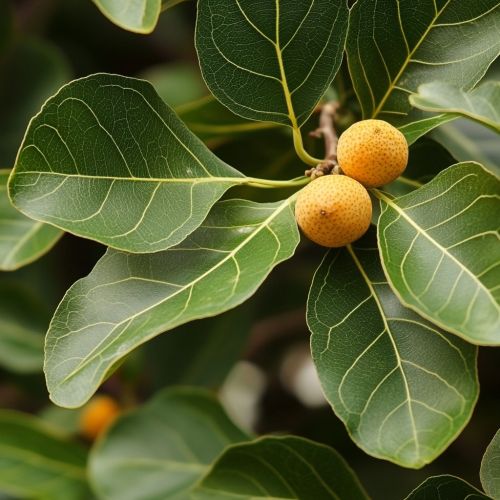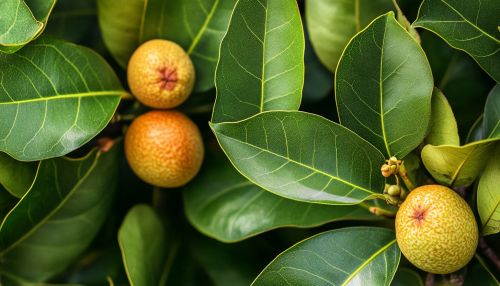Ficus carica: Difference between revisions
No edit summary |
No edit summary |
||
| Line 1: | Line 1: | ||
== Description == | == Description == | ||
[[Image:Detail-98235.jpg|thumb|center|Close-up of Ficus carica leaves and fruit.]] | [[Image:Detail-98235.jpg|thumb|center|Close-up of Ficus carica leaves and fruit.|class=only_on_mobile]] | ||
[[Image:Detail-98236.jpg|thumb|center|Close-up of Ficus carica leaves and fruit.|class=only_on_desktop]] | |||
'''Ficus carica''', commonly known as the common fig, is a species of flowering plant in the mulberry family, Moraceae. It is native to the Middle East and western Asia and has been cultivated since ancient times for its fruit, also referred to as the fig. The species is well known for its unique pollination mechanism involving fig wasps and its ability to thrive in a variety of climates. | '''Ficus carica''', commonly known as the common fig, is a species of flowering plant in the mulberry family, Moraceae. It is native to the Middle East and western Asia and has been cultivated since ancient times for its fruit, also referred to as the fig. The species is well known for its unique pollination mechanism involving fig wasps and its ability to thrive in a variety of climates. | ||
Latest revision as of 20:37, 8 October 2024
Description


Ficus carica, commonly known as the common fig, is a species of flowering plant in the mulberry family, Moraceae. It is native to the Middle East and western Asia and has been cultivated since ancient times for its fruit, also referred to as the fig. The species is well known for its unique pollination mechanism involving fig wasps and its ability to thrive in a variety of climates.
Taxonomy and Etymology
The genus name Ficus is derived from the Latin word for fig, while the species name carica refers to the region of Caria in Asia Minor, where the fig is believed to have been first cultivated. Ficus carica is one of the earliest plants to be cultivated by humans, with evidence of fig cultivation dating back to at least 5000 BCE.
Morphology
Ficus carica is a deciduous tree or large shrub, growing to a height of 7–10 meters. The plant has smooth, white bark and large, lobed leaves that are 12–25 cm long and 10–18 cm wide. The leaves are deeply lobed with three to five lobes, and their undersides are covered with fine hairs.
The fruit, known as a syconium, is a unique structure in which the flowers are borne internally. The syconium is pear-shaped and can vary in color from green to purple. The interior of the syconium contains numerous small flowers that develop into tiny, seed-like structures known as achenes.
Pollination and Reproduction
Ficus carica exhibits a unique pollination mechanism involving fig wasps of the family Agaonidae. The wasps enter the syconium through a small opening called the ostiole and pollinate the internal flowers. This mutualistic relationship is essential for the reproduction of both the fig tree and the wasp.
The species can reproduce both sexually, through the production of seeds, and asexually, through vegetative propagation. Cuttings from mature trees can be planted to produce new trees, a method commonly used in fig cultivation.
Cultivation and Uses
Ficus carica is widely cultivated for its fruit, which is consumed fresh, dried, or processed into various products such as jams, jellies, and pastries. The fig is rich in dietary fiber, vitamins, and minerals, making it a valuable addition to the human diet.
The tree is well-suited to Mediterranean climates, characterized by hot, dry summers and mild, wet winters. It can also be grown in temperate regions, provided it is protected from severe frost. Ficus carica prefers well-drained soils and full sun exposure.
Historical and Cultural Significance
The fig has played a significant role in various cultures and religions throughout history. It is mentioned in numerous ancient texts, including the Bible and the Quran, and has been associated with fertility, prosperity, and enlightenment. In ancient Greece and Rome, figs were considered a staple food and were often used in religious ceremonies.
Phytochemistry and Medicinal Properties
Ficus carica contains a variety of bioactive compounds, including flavonoids, phenolic acids, and enzymes such as ficin. These compounds have been studied for their potential health benefits, including antioxidant, anti-inflammatory, and anticancer properties. The latex of the fig tree has been traditionally used in folk medicine to treat warts, skin infections, and digestive disorders.
Environmental Impact and Conservation
Ficus carica plays an important role in its native ecosystems, providing food and habitat for various animal species, including birds, mammals, and insects. The tree's extensive root system helps prevent soil erosion and promotes soil health. Conservation efforts focus on preserving wild fig populations and their associated pollinators, which are essential for the species' continued survival.
